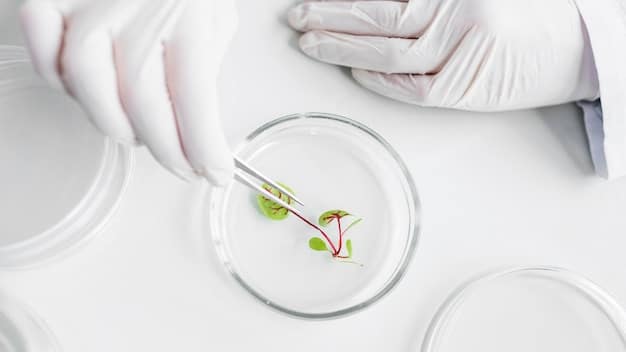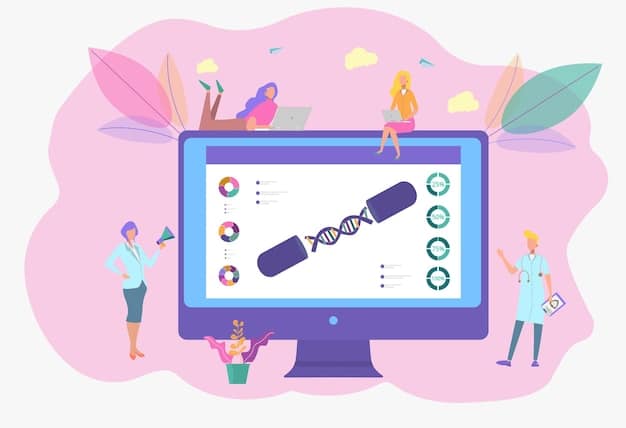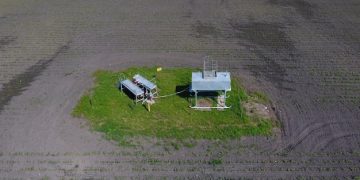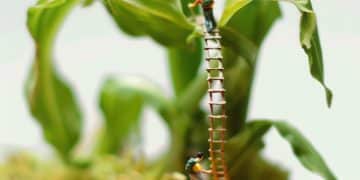Agricultural Biotechnology: Latest Advances in Drought-Resistant Crops

The latest advancements in agricultural biotechnology focus on developing drought-resistant and high-yielding crops through genetic engineering, gene editing, and advanced breeding techniques to enhance food security and sustainability.
The escalating challenges of climate change and a growing global population demand innovative solutions in agriculture. The latest advancements in agricultural biotechnology: developing drought-resistant and high-yielding crops are at the forefront of addressing these critical needs.
Understanding Agricultural Biotechnology
Agricultural biotechnology is a branch of science that uses biological processes to develop technologies that improve plant characteristics. These technologies can enhance crop yields, increase resistance to pests and diseases, and improve tolerance to environmental stresses such as drought.
By applying innovative techniques, agricultural biotechnology aims to create more sustainable and efficient farming practices, ensuring a stable food supply in the face of increasing global challenges. This interdisciplinary field combines genetics, molecular biology, and agronomy to transform agriculture.
Key Techniques in Agricultural Biotechnology
Several techniques are essential in modern agricultural biotechnology. Each plays a unique role in enhancing crop performance and resilience.
- Genetic Engineering: This involves modifying the genetic material of plants to introduce desirable traits, such as drought resistance or pest resistance.
- Gene Editing: Precise modifications to plant DNA are made using tools like CRISPR-Cas9, allowing for targeted improvements without introducing foreign genes.
- Marker-Assisted Breeding: DNA markers are used to identify plants with desirable traits, accelerating the breeding process and improving the efficiency of crop development.

These advancements are critical in addressing food security challenges and enabling farmers to produce more with less, contributing to a more sustainable agricultural system.
Developing Drought-Resistant Crops
Drought is a major threat to agriculture, causing significant yield losses and economic hardship for farmers. Developing drought-resistant crops is a key focus of agricultural biotechnology efforts worldwide.
Scientists are employing various strategies to enhance the ability of plants to withstand water scarcity, including genetic modification and advanced breeding techniques. These efforts aim to ensure that crops can thrive even in arid and semi-arid regions.
Genetic Modification for Drought Resistance
Through genetic modification, scientists can introduce specific genes that enhance drought tolerance in plants. This involves identifying genes that help plants conserve water or withstand stress conditions.
Several genes have been identified that play a role in drought resistance, such as those that regulate the closure of stomata (small pores on leaves) or enhance root development. Introducing these genes into crops can significantly improve their performance under drought conditions.
- Improved Water Use Efficiency: Genetically modified crops can use water more efficiently, reducing their dependence on irrigation.
- Enhanced Root Systems: Deeper and more extensive root systems enable plants to access water from deeper soil layers.
- Stress Tolerance: Certain genes can help plants withstand the physiological stress caused by drought, such as osmotic stress and oxidative damage.
These genetic modifications can lead to crops that not only survive but also maintain high yields even when water is scarce.
Enhancing Crop Yields Through Biotechnology
In addition to drought resistance, agricultural biotechnology is also focused on enhancing crop yields. Increasing productivity is crucial to meet the growing demand for food and feed worldwide.
By optimizing plant genetics, scientists can develop crops that are more efficient at utilizing resources such as sunlight and nutrients, resulting in higher yields per acre. These advancements are essential for sustainable agriculture.
Strategies for Increasing Crop Yields
Several biotechnological strategies are employed to boost crop yields, including optimizing photosynthesis, enhancing nutrient uptake, and improving plant architecture.
By manipulating plant genes, scientists can fine-tune these processes to maximize productivity. These strategies aim to create crops that are both high-yielding and resource-efficient, reducing the environmental footprint of agriculture.
- Optimizing Photosynthesis: Enhancing the efficiency of photosynthesis can increase the amount of energy plants capture from sunlight, leading to higher biomass production.
- Improved Nutrient Uptake: Modifying plant roots to improve nutrient absorption can help crops thrive in nutrient-poor soils.
- Enhanced Plant Architecture: Optimizing plant structure, such as leaf angle and branching patterns, can improve light capture and overall productivity.
These targeted improvements contribute to significant increases in crop yields, ensuring a more secure food supply for future generations.
Gene Editing Technologies: CRISPR and Beyond
Gene editing technologies, particularly CRISPR-Cas9, have revolutionized agricultural biotechnology. These tools allow scientists to make precise and targeted modifications to plant DNA, offering new possibilities for crop improvement.
Unlike traditional genetic modification, gene editing does not necessarily involve the introduction of foreign genes. Instead, it enables scientists to edit existing genes, fine-tuning plant traits with unprecedented precision.
CRISPR-Cas9: A Game-Changer in Agriculture
CRISPR-Cas9 is a powerful gene editing tool that allows scientists to target specific DNA sequences in plants. This technology has been used to enhance drought resistance, improve disease resistance, and boost crop yields.
The precision of CRISPR-Cas9 enables scientists to make targeted improvements without causing unintended effects, accelerating the development of improved crop varieties. This technology is transforming agricultural research and breeding.

- Precision Editing: CRISPR-Cas9 allows for precise and targeted modifications to plant DNA, minimizing off-target effects.
- Accelerated Breeding: This technology can significantly speed up the breeding process, allowing for faster development of improved crop varieties.
- Enhanced Traits: CRISPR-Cas9 has been used to enhance a wide range of traits in crops, including drought resistance, disease resistance, and yield.
These applications demonstrate the immense potential of gene editing technologies in addressing agricultural challenges and improving food security.
The Role of Marker-Assisted Breeding
Marker-assisted breeding (MAB) is a technique that uses DNA markers to identify plants with desirable traits. This approach accelerates the breeding process and improves the efficiency of crop development.
By identifying plants with specific genetic markers associated with traits such as drought resistance or high yield, breeders can select superior individuals for breeding programs, reducing the time and resources required to develop improved crop varieties.
Advantages of Marker-Assisted Breeding
MAB offers several advantages over traditional breeding methods, including increased efficiency, reduced breeding cycles, and improved selection accuracy.
This approach enables breeders to identify and select plants with desirable traits early in the breeding process, accelerating the development of improved crop varieties. MAB is a valuable tool for enhancing crop performance and resilience.
- Increased Efficiency: MAB reduces the time and resources required to develop improved crop varieties.
- Reduced Breeding Cycles: Selecting plants based on DNA markers shortens the breeding cycle.
- Improved Selection Accuracy: MAB improves the accuracy of selection, ensuring that plants with desirable traits are identified and used in breeding programs.
These benefits make MAB an essential component of modern agricultural biotechnology, contributing to the development of crops that are better suited to meet the challenges of a changing climate.
Challenges and Future Directions
Despite the significant advancements in agricultural biotechnology, several challenges remain. These include regulatory hurdles, public perception, and the need for sustainable and equitable access to these technologies.
Addressing these challenges is crucial to ensure that agricultural biotechnology can continue to contribute to food security and sustainable agriculture. Future research and development efforts should focus on enhancing the precision, efficiency, and accessibility of these technologies.
Addressing Key Challenges
Overcoming the challenges facing agricultural biotechnology requires a multi-faceted approach involving collaboration between scientists, policymakers, and the public. Key areas of focus include:
- Regulatory Frameworks: Developing clear and science-based regulatory frameworks that ensure the safety and efficacy of biotech crops.
- Public Perception: Addressing public concerns and misconceptions about agricultural biotechnology through education and outreach efforts.
- Sustainable Access: Ensuring that biotech crops are accessible to farmers in developing countries, enabling them to benefit from these technologies.
By addressing these challenges, agricultural biotechnology can continue to play a vital role in ensuring food security and promoting sustainable agriculture worldwide.
Conclusion
The latest advancements in agricultural biotechnology: developing drought-resistant and high-yielding crops represent a significant step forward in addressing the challenges of food security and climate change. By leveraging genetic engineering, gene editing, and marker-assisted breeding, scientists are creating crops that are more resilient, productive, and sustainable. While challenges remain, the continued development and responsible implementation of these technologies hold immense potential for transforming agriculture and ensuring a stable food supply for future generations.
| Key Point | Brief Description |
|---|---|
| 🌱 Drought Resistance | Developing crops that can thrive with less water. |
| 📈 High Yields | Increasing crop productivity to meet global demand. |
| 🧬 Gene Editing | Using CRISPR for precise crop improvements. |
| 🔬 Marker-Assisted Breeding | Accelerating breeding through DNA markers. |
Can biotechnology really help crops resist drought?
▼
Yes, biotechnology enhances drought resistance by modifying plant genes to improve water use efficiency and stress tolerance.
▼
Gene editing optimizes photosynthesis and nutrient uptake, leading to higher biomass production and better yields.
▼
CRISPR allows for precise targeting of DNA modifications, enhancing traits without introducing foreign genes, thereby accelerating breeding.
▼
Yes, marker-assisted breeding identifies plants with desirable traits early, which reduces breeding cycles and improves selection accuracy.
▼
Regulatory hurdles, public perception, and the necessity for sustainable and equitable access remain significant challenges.
Conclusion
In summary, the latest advancements in agricultural biotechnology show immense potential for creating drought-resistant and high-yielding crops. Addressing challenges like regulatory concerns and public perception will be key to realizing its full benefits.





